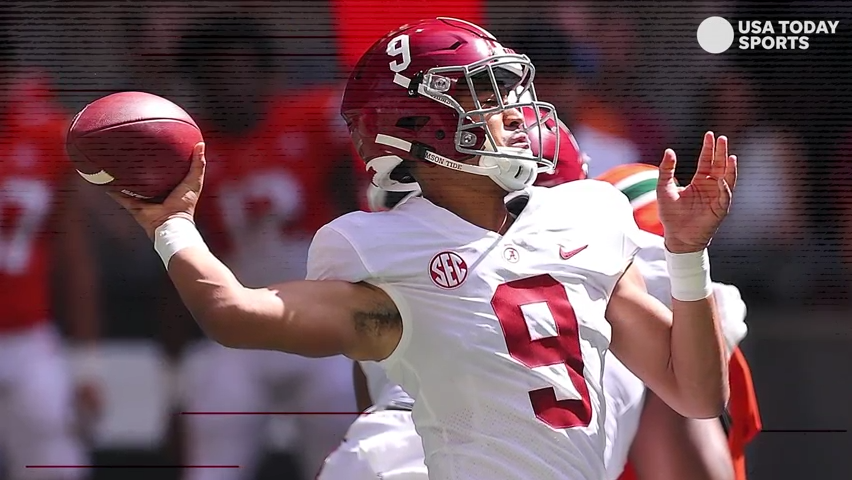Opinion: In college football, it's about results - not committee rankings. Playoff teams will emerge right on time.

This is why the College Football Playoff committee’s weekly rankings should be perpetually written in Comic Sans. This is why the outrage that spills out of people’s Twitter fingers every Tuesday night would be better spent on literally anything else.
For all the focus on the 13 people who waste their time every week flying to Dallas to spend two days at an overpriced resort debating strength of schedule numbers, college football isn’t about them. It’s about who performs week in and week out over the course of three-plus months. And as usual, the season will sort itself out right on time.
The process of separating the true contenders from the rest of the pack always happens in November. And look what we’ve learned already.
Wake Forest? Enjoy a New Year’s Six bowl — if you can get there as the ACC champion.
Baylor? You’re a spoiler and nothing more.
Michigan State? You’re still in it technically, but the mask is coming off.
Cincinnati? You’re still unbeaten, but you’re not making it difficult for the selection committee to put the shiv in your back.
MORE: Ole Miss, Lane Kiffin apologize to Huge Freeze for 'classless' Tweets
MORE: Purdue does it again, knocks off No. 6 Michigan State
MORE: No. 3 Alabama holds on for ugly win against LSU
WINNERS AND LOSERS: Arizona wins for first time in more than two years
For a Saturday that looked like a snoozefest on paper, we sure learned a lot about several teams that were very much in the ballgame based on the committee’s first rankings.
Michigan State, which had risen to No. 3 after a surprising 8-0 start, finally fell flat at Purdue in a 40-29 loss.
Wake Forest, whose coach Dave Clawson suggested that brand bias may have played a role in being ranked No. 9 as an unbeaten ACC team, finally got burned for having a subpar defense in a 58-55 loss to North Carolina.
Baylor, which could have conceivably been in the playoff contention by winning out, instead notched a second loss. It wasn’t a good one, falling 30-28 at TCU.
And then there’s Cincinnati, for whom there was much hand-wringing over being ranked No. 6. As it turns out after the Bearcats barely survived Tulsa, 28-20, it may have actually been a generous assessment.
All of this is perfectly normal behavior for college football teams that have spent the first two months riding confidence and momentum to prominent positions that seemed unlikely when the season started. By this point in the season, the pressure starts to mount for teams in contention. Sustaining a high level of energy and emotion every week becomes really difficult. And as the process moves along, we find out who these teams really are.
On one hand, not a lot changed Saturday. Baylor and Wake Forest were significant longshots to make the Playoff in the first place, so losing only eliminated them from something that wasn’t likely to happen under any circumstances.
Michigan State, despite putting in a poor performance against Purdue, can still win the Big Ten and get into the Playoff as a one-loss team. The Spartans’ game at Ohio State on Nov. 20 was always going to make or break their season.
And then there’s Cincinnati, which ends this week just as it began: Unbeaten, but with loads of doubters after needing to stop Tulsa twice inside the 5-yard line to stave off a potential overtime.
At the same time, these results go to show why it’s silly to stress out about what the committee says while the season is still evolving. Over the course of 13 games, teams face all kinds of different tests. What’s true one week may not be true the next. At the end, water finds its level.
That’s why, for better or worse, we typically end up with the same group of teams making the Playoff year after year. Over time, the best teams are going to emerge. You can’t fluke your way into the final four. Whatever biases the committee might have will eventually succumb to the results.
Though it would be good for the sport in many ways to expand the CFP to eight or 12 teams, there’s a certain cleanliness to the four-team format.
In the first seven years of the system, there’s been one minor controversy. That was in 2014 when Ohio State got in over Big 12 co-champions Baylor and TCU and went on to win the national title. The only other time a one-loss champion of a power conference got left out was Ohio State in 2018, and nobody cried foul on that one because the Buckeyes had lost by 29 points to Purdue.
In other words, this is all going to work itself out by the end. Ranking these teams every week generates a lot of angst and discontent, but as we saw Saturday, the teams who make the Playoff will ultimately choose themselves.
Follow Paste BN Sports columnist Dan Wolken on Twitter @DanWolken